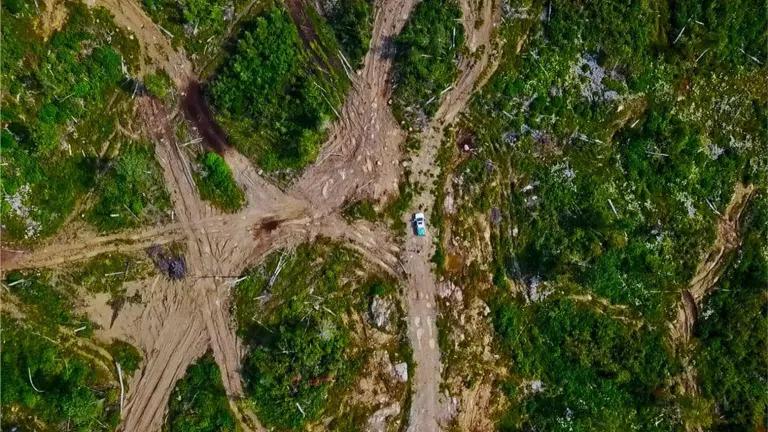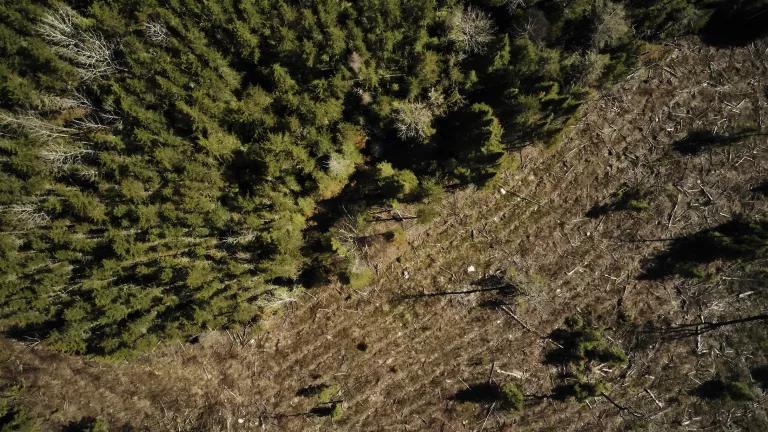Canada’s Forward Step on Climate Falls Short
Canada’s failure to commit to reducing its emissions by up to 52 percent by 2030 puts it out of step with the United States, demonstrating a failure to come to grips with the long term trajectory of its tar sands sector in a world transitioning to clean energy or to fully seize the opportunity to protect and rehabilitate its carbon rich forests.

Canada's deforestation figures undercount decades old scars such as these in northern Ontario
Prime Minister Trudeau has announced that Canada will reduce its emissions by up to 45 percent by 2030 – a goal that improves on its previous target but falls short both of the United States commitment as well as what is needed to align Canada with a 1.5°C aligned path. Canada can and should meet the U.S. climate commitment of reducing its carbon emissions by up to 52 percent by 2030. Such a target is achievable, though still short of the fair share target of reducing Canada’s emissions by at least 60 percent below 2030. However, in order to meet U.S. ambition levels, Canada will have to acknowledge that there is no place for a growing tar sands industry in a global economy transitioning to clean energy. Fortunately, it has the potential to harness its vast forests to support greater climate ambition; but before it can do so, it must advance a credible framework for assessing carbon emissions from industrial activities that supports the protection and enhancement of its carbon rich forests.
Canada's projections of tar sands expansion are inconsistent with global climate action
The Trudeau government has not come to grips with the fact that an expanding tar sands industry is fundamentally incompatible with both Canada’s aspirations for climate leadership or a global economy transitioning to clean forms of energy. This disconnect is clear in how the Trudeau government modeled its pathway to 2030 – which showed domestic emission reductions associated with its December Climate Plan while forecasting a rapidly expanding tar sands industry that would export into a global market for oil that is fundamentally inconsistent with meaningful international action on climate.
The upstream emissions from Canada’s oil and gas sector accounts for more than a quarter of its total emissions. However, because Canada exports the majority of its oil and the vast majority of emissions from oil production – 80% to 90% - occurs where it is consumed, the existence of a robust, longer term market for Canadian oil requires global inaction on climate. But a scenario in which the rest of the world doesn’t meaningful policies to reduce global emissions is what Canada is implicitly planning for in its modeling.
While Canada announced a series of ambitious policies to reduce its domestic emissions in December 2020, it continues to project that its oil production will not peak until 2045, growing from 4.6 million barrels per day to 7.2 million bpd. Of course, for this to happen, global oil prices need to reach $75/barrel in 2026 and stay there – a scenario that explicitly assumes no meaningful climate ambition on the part of major oil consuming countries.
Other sources recognize the poor long-term prospects for a robust global oil market in a world acting to address climate change. Indeed, Wood Mackenzie recently projected that decisive action to limit climate change to just 2°C - short of our 1.5°C goal - would lead to oil prices between $37 and $42 a barrel by 2030 and a continued decline to $10 a barrel by 2050. This is well below the breakeven prices of $78 per barrel for new in situ tar sands projects - the lowest cost type of tar sands expansion project - reported by Rystad.
The Biden Administration’s announcement that the United States will reduce its carbon emissions by more than 50% by 2030, joined by a host of major economies during the Climate Leaders’ Summit, demonstrates that Canada needs to reconsider its assumptions around its oil and gas sector and advance a stronger target.
Canada's forests present an untapped opportunity for greater climate ambition
One of the most cost-effective strategies for combating climate change is to protect our intact forests – and Canada’s boreal forest is the world’s largest and most carbon rich forest, holding nearly twice as much carbon as the world’s combined oil reserves. Canada has an enormous opportunity to harness the immense potential of its intact forest and hundreds of millions of acres of managed forests to support more climate change ambition. However, Canada must establish a credible framework for assessing carbon emissions from its forests before it can harness the vast potential of Canada’s forests as a natural climate solution – and it has work to do.
Canada’s intact forests are being lost at a rate faster than any country other than Russia or Brazil. It’s logging industry clearcuts over a million acres of carbon-rich boreal forest each year. However, a combination of poor monitoring practices and strategic use of accounting rules has allowed Canada to obscure the significant climate impacts of its industrial activities in its forests. A recent study in Ontario has shown that deforestation rates are as much as fifty times higher than the province reports. While the practice that leads to these poor regrowth outcomes – whole tree logging – is used throughout Canada’s boreal forest, Canadian government’s monitoring system lacks the resolution to identify de facto deforestation. Moreover, Canada uses a series of accounting measures which significantly underestimate the net emissions from industrial activities in Canada’s forests.
Internationally, Canada has the opportunity to play a more positive role in efforts to protect our global intact forests and protect the rights of Indigenous Peoples. But that will require Canada distinguishing its international forest agenda from that of its logging industry. Recently, the Canadian government opposed legislation in California and New York which would prevent state contractors from purchasing forest products connected with deforestation, intact forest degradation or the exploitation of Indigenous Peoples in boreal or tropical countries. Interventions of this kind fundamentally undermine Canada’s credibility as a partner in efforts to advance the protection of the Amazon and in ongoing conversations with the United States around a Buy Clean approach to government procurement policies.
What's Next?
The Trudeau government has an opportunity to join the global climate leader that have set a target to meet or exceed a goal of reducing 2005 emissions by 50 percent by 2030. In their meeting prior to the Climate Leaders Summit, President Biden and Prime Minister Trudeau reaffirmed their shared commitment to continue the U.S.-Canada High Level Dialogue on Climate Ambition. This bilateral dialogue is a space that the U.S. and Canada specifically created to identify opportunities to enhance our climate ambition, support regulatory alignment and work together on policies that will better measure and manage land carbon sinks.
One of the easiest ways for Canada to enhance its climate ambition is simply to reconsider its 2030 emissions in a world that is acting decisively on climate - one which will not support the oil demand or prices that will enable a historic expansion of Canada's oil and gas sector. The United States and Canada also need to reconsider how they can work together to create a new standard for monitoring and accounting forest carbon which sets a credible framework for investments in natural climate solutions that prioritizes the climate, protecting biodiversity and upholding the rights of Indigenous Peoples. Finally, the U.S. and Canada can continue to identify additional opportunities to support cross-border policies that expedite both the clean energy economy and a just transition from fossil fuels.
Canada has taken a step forward - but has left far too much on the table. The urgency of this moment demands more - and it will be critical for the U.S. and Canadian governments to work together this year to find a path for an harmonized, more ambitious approach.




